2009 Hyundai Santa Fe air condition
[x] Cancel search: air conditionPage 203 of 269
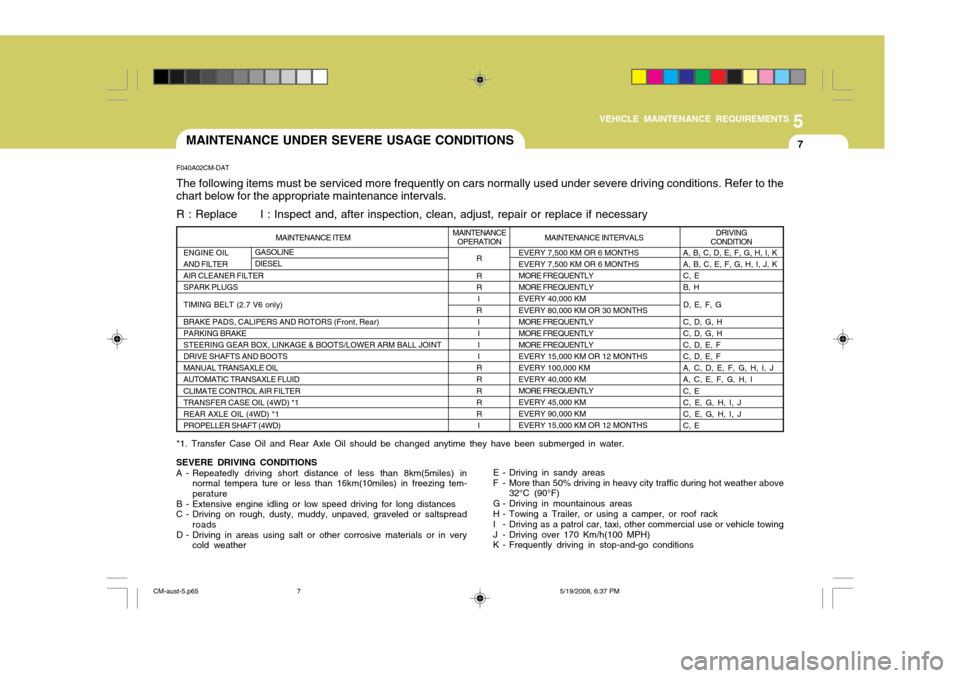
5
VEHICLE MAINTENANCE REQUIREMENTS
7MAINTENANCE UNDER SEVERE USAGE CONDITIONS
F040A02CM-DAT The following items must be serviced more frequently on cars normally used under severe driving conditions. Refer to the chart below for the appropriate maintenance intervals. R : Replace I : Inspect and, after inspection, clean, adjust, repair or replace if necessary
SEVERE DRIVING CONDITIONS
A - Repeatedly driving short distance of less than 8km(5miles) in normal tempera ture or less than 16km(10miles) in freezing tem- perature
B - Extensive engine idling or low speed driving for long distances
C - Driving on rough, dusty, muddy, unpaved, graveled or saltspread roads
D - Driving in areas using salt or other corrosive materials or in very cold weather E - Driving in sandy areas
F - More than 50% driving in heavy city traffic during hot weather above 32°C (90°F)
G - Driving in mountainous areas
H - Towing a Trailer, or using a camper, or roof rack
I - Driving as a patrol car, taxi, other commercial use or vehicle towing
J - Driving over 170 Km/h(100 MPH)
K - Frequently driving in stop-and-go conditions
*1. Transfer Case Oil and Rear Axle Oil should be changed anytime they have been submerged in water. MAINTENANCE INTERVALS
ENGINE OIL AND FILTERAIR CLEANER FILTERSPARK PLUGS TIMING BELT (2.7 V6 only)BRAKE PADS, CALIPERS AND ROTORS (Front, Rear) PARKING BRAKESTEERING GEAR BOX, LINKAGE & BOOTS/LOWER ARM BALL JOINTDRIVE SHAFTS AND BOOTSMANUAL TRANSAXLE OILAUTOMATIC TRANSAXLE FLUID CLIMATE CONTROL AIR FILTER TRANSFER CASE OIL (4WD) *1REAR AXLE OIL (4WD) *1PROPELLER SHAFT (4WD)
A, B, C, D, E, F, G, H, I, K A, B, C, E, F, G, H, I, J, KC, EB, H D, E, F, GC, D, G, H C, D, G, HC, D, E, FC, D, E, FA, C, D, E, F, G, H, I, JA, C, E, F, G, H, I C, E C, E, G, H, I, JC, E, G, H, I, JC, E
MAINTENANCE ITEM DRIVING
CONDITION
EVERY 7,500 KM OR 6 MONTHS EVERY 7,500 KM OR 6 MONTHSMORE FREQUENTLYMORE FREQUENTLYEVERY 40,000 KM EVERY 80,000 KM OR 30 MONTHS MORE FREQUENTLYMORE FREQUENTLYMORE FREQUENTLYEVERY 15,000 KM OR 12 MONTHSEVERY 100,000 KM EVERY 40,000 KM MORE FREQUENTLYEVERY 45,000 KMEVERY 90,000 KMEVERY 15,000 KM OR 12 MONTHS
R R R
I
R
IIII
RR R RR
I
MAINTENANCE
OPERATIONGASOLINE DIESEL
CM-aust-5.p65 5/19/2008, 6:37 PM
7
Page 207 of 269
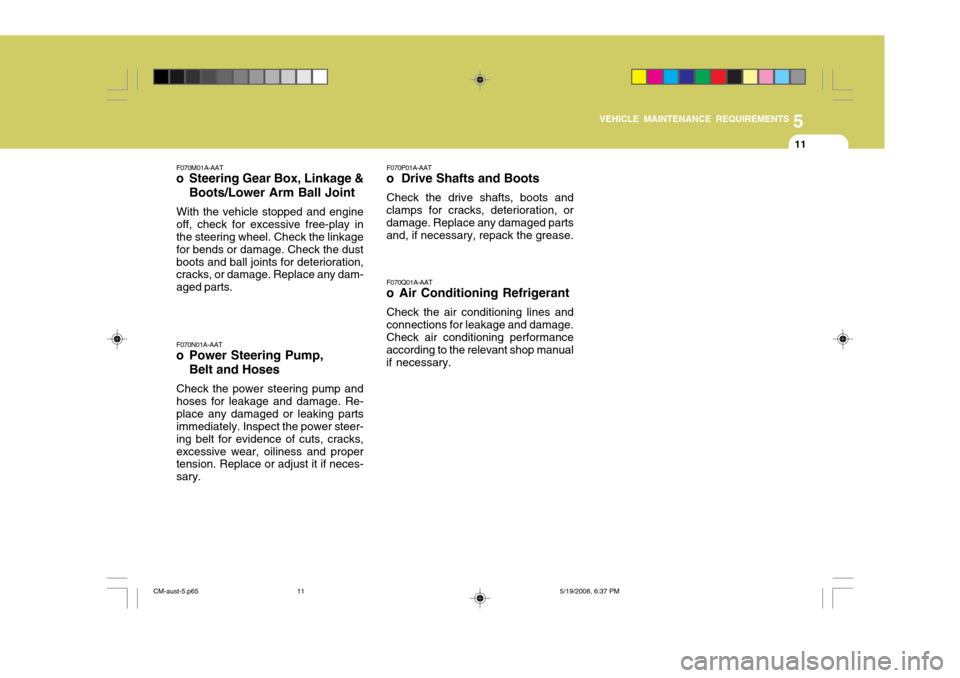
5
VEHICLE MAINTENANCE REQUIREMENTS
11
F070M01A-AAT
o Steering Gear Box, Linkage &
Boots/Lower Arm Ball Joint
With the vehicle stopped and engine off, check for excessive free-play in the steering wheel. Check the linkage for bends or damage. Check the dustboots and ball joints for deterioration, cracks, or damage. Replace any dam- aged parts. F070N01A-AAT
o Power Steering Pump,
Belt and Hoses
Check the power steering pump and hoses for leakage and damage. Re-place any damaged or leaking parts immediately. Inspect the power steer- ing belt for evidence of cuts, cracks,excessive wear, oiliness and proper tension. Replace or adjust it if neces- sary. F070P01A-AAT
o Drive Shafts and Boots
Check the drive shafts, boots and
clamps for cracks, deterioration, or damage. Replace any damaged parts and, if necessary, repack the grease.
F070Q01A-AAT
o Air Conditioning Refrigerant
Check the air conditioning lines and
connections for leakage and damage.Check air conditioning performance according to the relevant shop manual if necessary.
CM-aust-5.p65 5/19/2008, 6:37 PM
11
Page 208 of 269
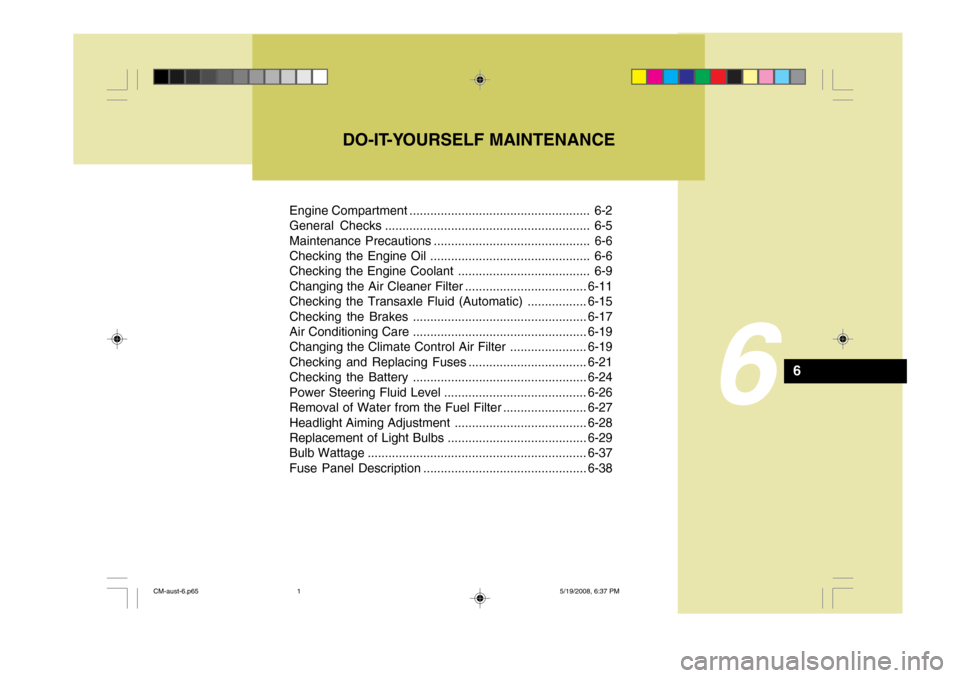
Engine Compartment .................................................... 6-2
General Checks ........................................................... 6-5
Maintenance Precautions ............................................. 6-6
Checking the Engine Oil .............................................. 6-6
Checking the Engine Coolant ...................................... 6-9
Changing the Air Cleaner Filter ...................................6-11
Checking the Transaxle Fluid (Automatic) .................6-15
Checking the Brakes .................................................. 6-17
Air Conditioning Care .................................................. 6-19
Changing the Climate Control Air Filter .. ....................6-19
Checking and Replacing Fuses ..................................6-21
Checking the Battery .................................................. 6-24
Power Steering Fluid Level ......................................... 6-26
Removal of Water from the Fuel Filter ........................6-27
Headlight Aiming Adjustment ...................................... 6-28
Replacement of Light Bulbs ........................................6-29
Bulb Wattage ............................................................... 6-37
Fuse Panel D escription ............................................... 6-38
DO-IT-YOURSELF MAINTENANCE
6
6
CM-aust-6.p65
5/19/2008, 6:37 PM
1
Page 212 of 269
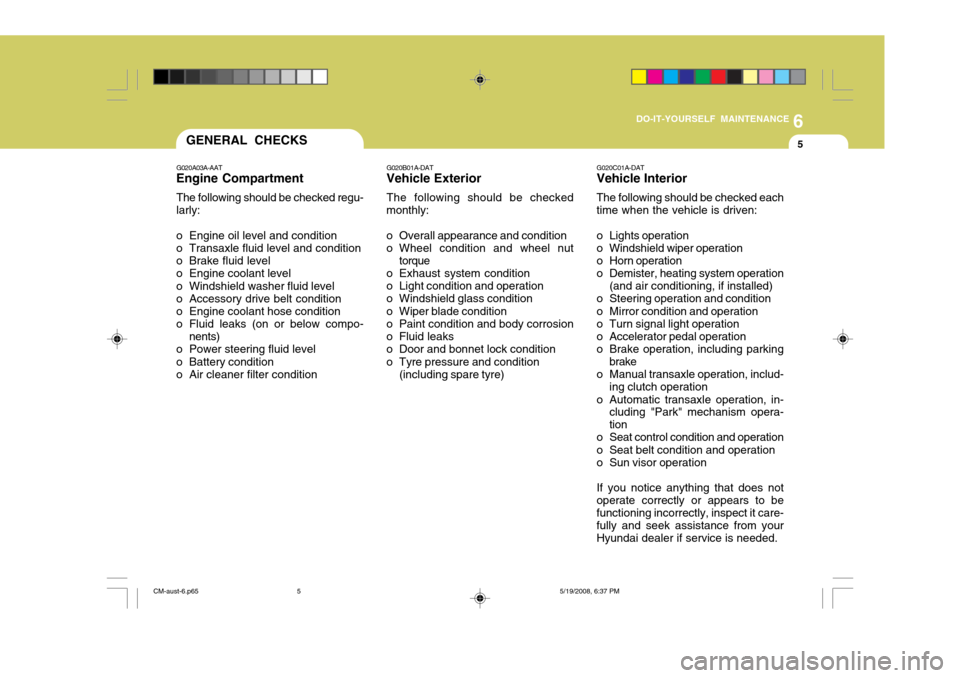
6
DO-IT-YOURSELF MAINTENANCE
5GENERAL CHECKS
G020A03A-AAT
Engine Compartment
The following should be checked regu- larly:
o Engine oil level and condition
o Transaxle fluid level and condition
o Brake fluid level
o Engine coolant level
o Windshield washer fluid level
o Accessory drive belt condition
o Engine coolant hose condition
o Fluid leaks (on or below compo- nents)
o Power steering fluid level
o Battery condition
o Air cleaner filter condition G020B01A-DAT
Vehicle Exterior
The following should be checked
monthly:
o Overall appearance and condition
o Wheel condition and wheel nut
torque
o Exhaust system condition
o Light condition and operation
o Windshield glass condition
o Wiper blade condition
o Paint condition and body corrosion
o Fluid leaks
o Door and bonnet lock condition
o Tyre pressure and condition (including spare tyre) G020C01A-DAT Vehicle Interior The following should be checked each time when the vehicle is driven:
o Lights operation
o Windshield wiper operation
o Horn operation
o Demister, heating system operation
(and air conditioning, if installed)
o Steering operation and condition
o Mirror condition and operation
o Turn signal light operation
o Accelerator pedal operation
o Brake operation, including parking
brake
o Manual transaxle operation, includ-
ing clutch operation
o Automatic transaxle operation, in- cluding "Park" mechanism opera-tion
o Seat control condition and operation
o Seat belt condition and operation
o Sun visor operation If you notice anything that does not operate correctly or appears to befunctioning incorrectly, inspect it care- fully and seek assistance from your Hyundai dealer if service is needed.
CM-aust-6.p65 5/19/2008, 6:37 PM
5
Page 218 of 269
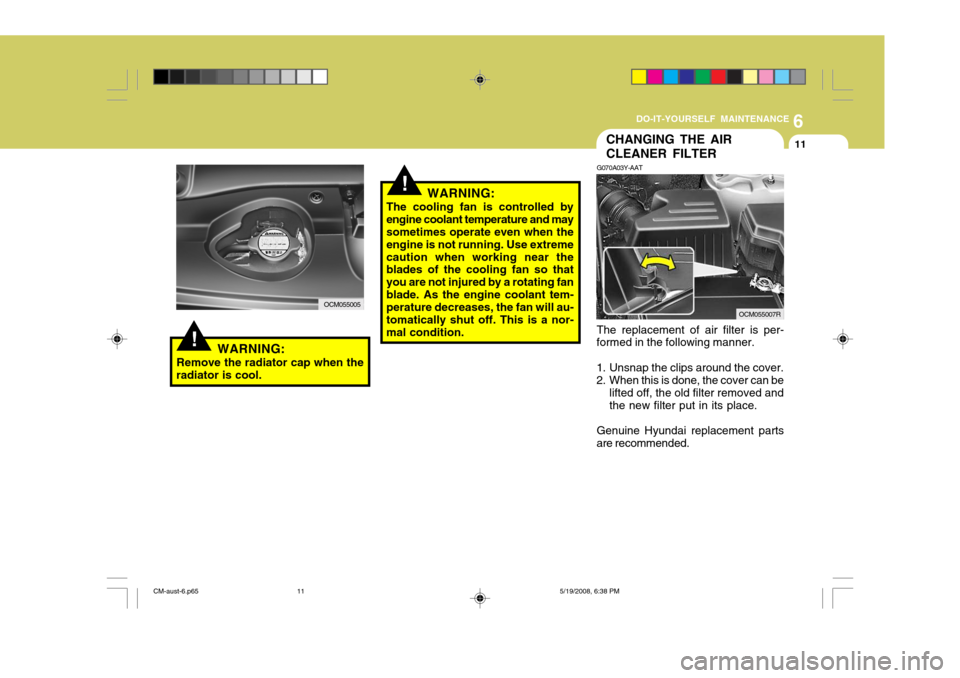
6
DO-IT-YOURSELF MAINTENANCE
11
!
!
CHANGING THE AIR CLEANER FILTER
G070A03Y-AAT The replacement of air filter is per-
formed in the following manner.
1. Unsnap the clips around the cover.
2. When this is done, the cover can be lifted off, the old filter removed and the new filter put in its place.
Genuine Hyundai replacement parts
are recommended.
WARNING:
The cooling fan is controlled byengine coolant temperature and may sometimes operate even when the engine is not running. Use extremecaution when working near the blades of the cooling fan so that you are not injured by a rotating fanblade. As the engine coolant tem- perature decreases, the fan will au- tomatically shut off. This is a nor-mal condition.
WARNING:
Remove the radiator cap when the
radiator is cool.
OCM055005OCM055007R
CM-aust-6.p65 5/19/2008, 6:38 PM
11
Page 226 of 269
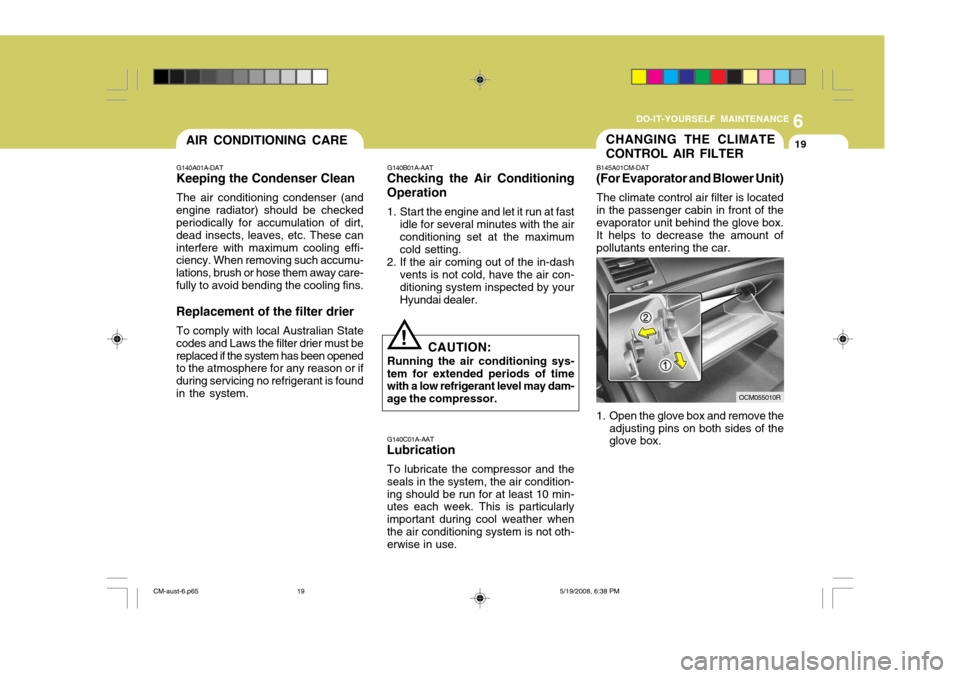
6
DO-IT-YOURSELF MAINTENANCE
19CHANGING THE CLIMATE CONTROL AIR FILTER
B145A01CM-DAT
(For Evaporator and Blower Unit)
The climate control air filter is located in the passenger cabin in front of the evaporator unit behind the glove box. It helps to decrease the amount of pollutants entering the car.
1. Open the glove box and remove the adjusting pins on both sides of the glove box.
G140C01A-AAT
Lubrication
To lubricate the compressor and the seals in the system, the air condition-ing should be run for at least 10 min- utes each week. This is particularly important during cool weather whenthe air conditioning system is not oth- erwise in use.
!
G140B01A-AAT
Checking the Air Conditioning Operation
1. Start the engine and let it run at fast
idle for several minutes with the air conditioning set at the maximum cold setting.
2. If the air coming out of the in-dash vents is not cold, have the air con-ditioning system inspected by yourHyundai dealer.
CAUTION:
Running the air conditioning sys-
tem for extended periods of time with a low refrigerant level may dam- age the compressor.
OCM055010R
AIR CONDITIONING CARE
G140A01A-DAT
Keeping the Condenser Clean
The air conditioning condenser (and
engine radiator) should be checked periodically for accumulation of dirt, dead insects, leaves, etc. These caninterfere with maximum cooling effi- ciency. When removing such accumu- lations, brush or hose them away care-fully to avoid bending the cooling fins. Replacement of the filter drier
To comply with local Australian State
codes and Laws the filter drier must be replaced if the system has been opened to the atmosphere for any reason or if during servicing no refrigerant is foundin the system.
CM-aust-6.p65 5/19/2008, 6:38 PM
19
Page 233 of 269
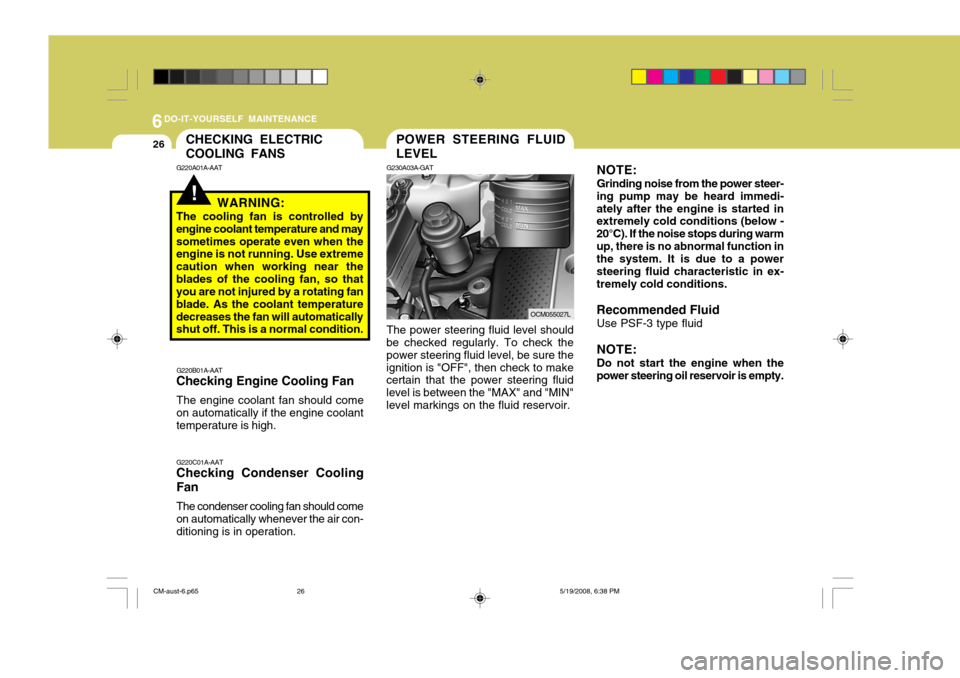
6DO-IT-YOURSELF MAINTENANCE
26
!
POWER STEERING FLUID LEVELCHECKING ELECTRIC COOLING FANS
G220A01A-AAT
WARNING:
The cooling fan is controlled by engine coolant temperature and maysometimes operate even when the engine is not running. Use extreme caution when working near theblades of the cooling fan, so that you are not injured by a rotating fan blade. As the coolant temperaturedecreases the fan will automatically shut off. This is a normal condition.
G220B01A-AAT
Checking Engine Cooling Fan
The engine coolant fan should come
on automatically if the engine coolant temperature is high. G220C01A-AAT Checking Condenser Cooling Fan The condenser cooling fan should come on automatically whenever the air con- ditioning is in operation. G230A03A-GAT The power steering fluid level should
be checked regularly. To check the power steering fluid level, be sure theignition is "OFF", then check to make certain that the power steering fluid level is between the "MAX" and "MIN"level markings on the fluid reservoir.
OCM055027L NOTE: Grinding noise from the power steer-
ing pump may be heard immedi- ately after the engine is started in extremely cold conditions (below - 20°C). If the noise stops during warmup, there is no abnormal function in the system. It is due to a power steering fluid characteristic in ex-tremely cold conditions. Recommended Fluid
Use PSF-3 type fluidNOTE: Do not start the engine when the
power steering oil reservoir is empty.
CM-aust-6.p65 5/19/2008, 6:38 PM
26
Page 256 of 269
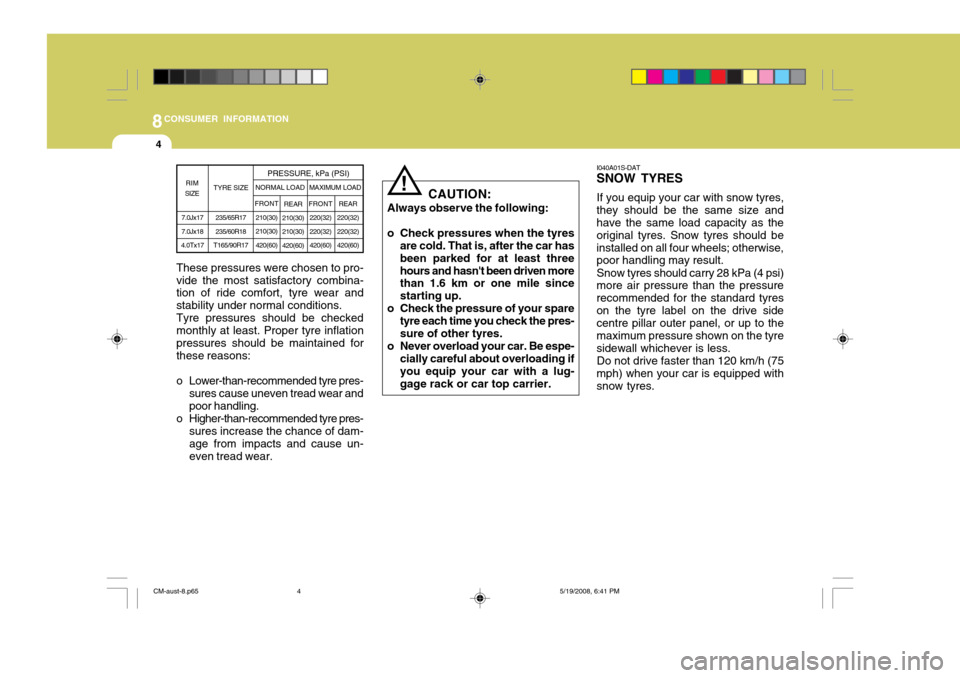
8CONSUMER INFORMATION
4
!
CAUTION:
Always observe the following:
o Check pressures when the tyres are cold. That is, after the car has been parked for at least threehours and hasn't been driven more than 1.6 km or one mile since starting up.
o Check the pressure of your spare tyre each time you check the pres-sure of other tyres.
o Never overload your car. Be espe- cially careful about overloading if you equip your car with a lug- gage rack or car top carrier. I040A01S-DAT
SNOW TYRES
If you equip your car with snow tyres,
they should be the same size and have the same load capacity as the original tyres. Snow tyres should beinstalled on all four wheels; otherwise, poor handling may result.
Snow tyres should carry 28 kPa (4 psi)
more air pressure than the pressure recommended for the standard tyreson the tyre label on the drive side centre pillar outer panel, or up to the maximum pressure shown on the tyresidewall whichever is less.
Do not drive faster than 120 km/h (75
mph) when your car is equipped withsnow tyres.
These pressures were chosen to pro-vide the most satisfactory combina- tion of ride comfort, tyre wear and stability under normal conditions.Tyre pressures should be checkedmonthly at least. Proper tyre inflationpressures should be maintained for these reasons:
o Lower-than-recommended tyre pres-
sures cause uneven tread wear and poor handling.
o Higher-than-recommended tyre pres-
sures increase the chance of dam- age from impacts and cause un- even tread wear.
7.0Jx17 7.0Jx18
4.0Tx17 TYRE SIZE
RIM
SIZE PRESSURE, kPa (PSI)
235/65R17235/60R18
T165/90R17 REAR
210(30)210(30)420(60) FRONT
220(32)220(32) 420(60)
NORMAL LOAD
MAXIMUM LOAD
REAR
220(32) 220(32) 420(60)
FRONT
210(30) 210(30)420(60)
CM-aust-8.p65 5/19/2008, 6:41 PM
4